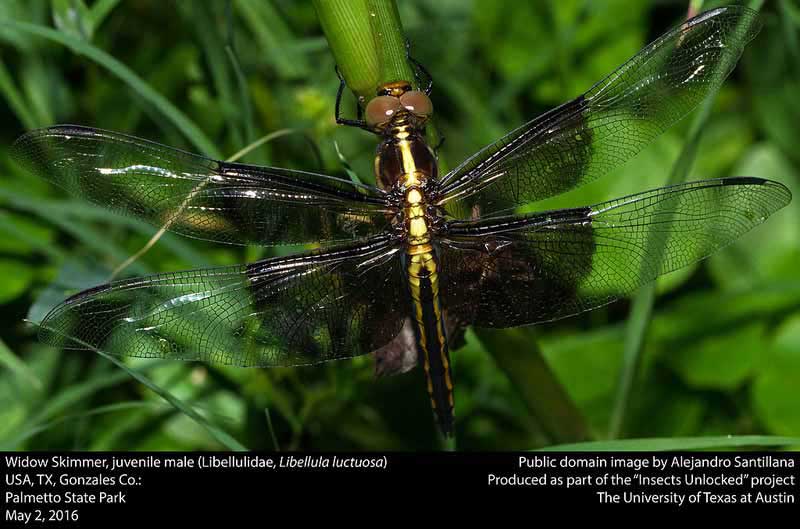
Superregnum: Eukaryota
Cladus: Unikonta
Cladus: Opisthokonta
Cladus: Holozoa
Regnum: Animalia
Subregnum: Eumetazoa
Cladus: Bilateria
Cladus: Nephrozoa
Cladus: Protostomia
Cladus: Ecdysozoa
Cladus: Panarthropoda
Phylum: Arthropoda
Subphylum: Hexapoda
Classis: Insecta
Cladus: Dicondylia
Subclassis: Pterygota
Cladus: Metapterygota
Cladus: Odonatoptera
Cladus: Holodonata
Ordo: Odonata
Subordo: Epiprocta
Infraordo: Anisoptera
Superfamilia: Libelluloidea
Familia: Libellulidae
Subfamilia: Libellulinae
Genus: Libellula
Species: Libellula luctuosa
Name
Libellula luctuosa Burmeister, 1839
Vernacular names
English: Widow Skimmer

Widow Skimmer (Libellula luctuosa) is one of the group of dragonflies known as king skimmers. The nymphs live in the water, molting and growing until they are ready to emerge from the water and then molting a final time to reveal their wings.
Anatomy and Morphology
Widow skimmers have large bulky bodies, with large heads. Adults have a steely blue body area but juveniles are yellow with brown stripes.[1] Eyes are also large and close together meeting in the middle of the head.[2] They have three pairs of legs. Legs are black in color. They have two pairs of wings: forewings and hindwings. Wings of both sexes are marked with prominent black basal bands. They keep their wings extended over their bodies. Adult males develop broad white spots at midwing as they mature. The abdomen measures 24–32 mm.[3] They also have a slight white hue on their abdomen and thorax.
Distribution
This species can be found commonly across the United States (except in the higher Rocky Mountains areas) and in southern Ontario and Quebec.[4]
Habitat
This species is found commonly in muddy substrates, or still bodies of waters such as ponds, lakes, streams, and creeks.[2][5]
Behavior
They are predators that prey on other insects such as mosquitoes.[2][6] They catch their prey using their legs and use their fangs to bring prey into their mouth.[2][6]
The process of reproduction is known as "in tandem." Position themselves to form a wheel or heart shape before sperm is transferred.[2][6]
References
Dunkle, S.W. 2000. Dragonflies through Binoculars, Toronto:Oxford University press.
"Common Dragonflies and Damselflies of Maryland". dnr2.maryland.gov. Retrieved 2017-03-29.
"OdonataCentral". www.odonatacentral.org. Retrieved 2017-03-29.
Mead, Kurt. 2009. Dragonflies of the North Woods, Duluth:Kollath+Stensaas.
"Maryland Biodiversity Project - Widow Skimmer (Libellula luctuosa)". www.marylandbiodiversity.com. Retrieved 2017-03-29.
"dragonfly | insect". Encyclopedia Britannica. Retrieved 2017-03-29.
Retrieved from "http://en.wikipedia.org/"
All text is available under the terms of the GNU Free Documentation License

